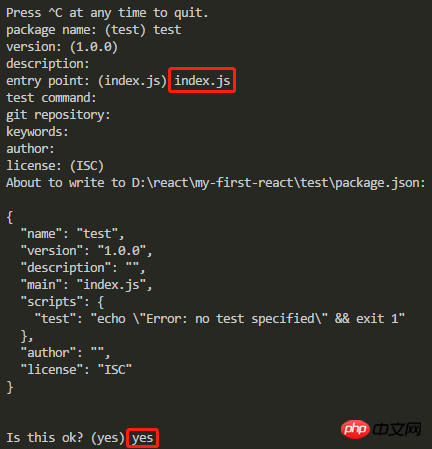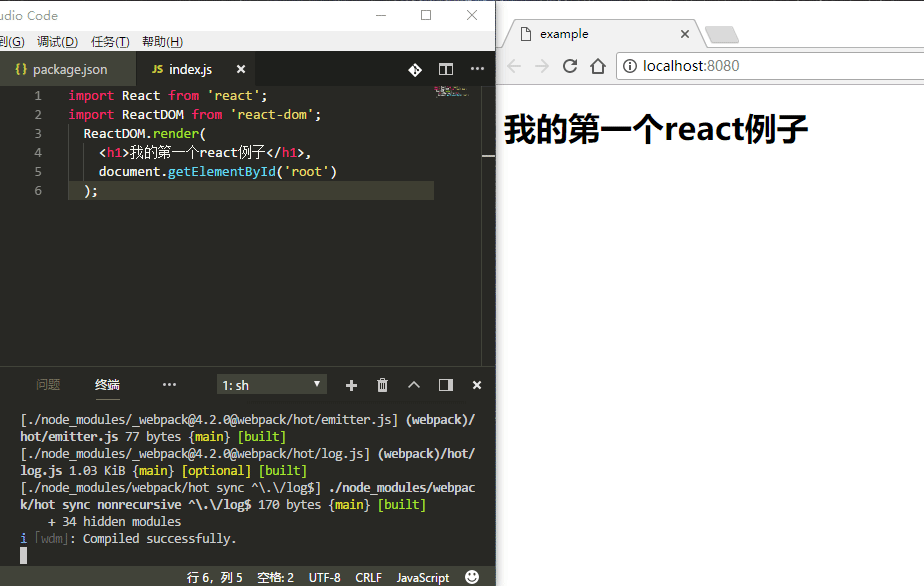Use webpack to make ReactApp
This time I will bring you the use of webpack to make ReactApp. What are the precautions for using webpack to make ReactApp? The following is a practical case, let’s take a look.
To learn React, you can directly create a ReactApp using the following method. This article mainly introduces how to set up this environment manually.
npm install -g create-react-app create-react-app my-app cd my-app npm start
Using Taobao NPM image
Using React and Webpack requires installing a lot of dependency packages. Without an agent, the speed will be very slow and very slow. It is easy to make mistakes, so it is recommended to use Taobao's npm image to install, the speed is very ideal.
It only takes two steps to install the npm package using Taobao mirror:
Install cnpm
npm install -g cnpm --registry=https://registry.npm.taobao.org
Use cnpm to install the package
Just replace npm Become cnpm to get high-speed downloads.
cnpm install [name]
All the commands for installing dependent packages given below are installed using cnpm. You can also use npm.
Start the first React
Initialize a json configuration file
npm init
Enter some information after executing the above command to create a json file. This file can also be created manually. The entry point needs to be filled in index.js, the rest is optional.

Install React
cnpm install react react-dom --save
Install the compilation tool babel
Copy code The code is as follows :
cnpm install babel-core babel-loader babel-preset-react babel-preset-es2015 --save-dev
Install packaging tool wepback
It is best to install both the global and current folder, so that you can package it in a fancy way.
cnpm install webpack webpack-cli --save-dev cnpm install webpack-dev-server --save-dev cnpm install webpack webpack-cli -g cnpm install webpack-dev-server -g
Configuration webpack
For convenience, all the following files are built in the same folder.
Create new webpack.config.js and add the following content
const path =require('path');
module.exports = {
entry: path.resolve(__dirname, 'index.js'),
output: {
path: path.resolve(__dirname, ''),
filename: "bundle.js"
},
mode: 'development',
module: {
rules: [
{
test: /\.js$/,
exclude: /node_modules/,
loader: "babel-loader",
options: {
presets: ["es2015","react"]
}
}
]
}
};In webpack4, there will be a warning if the mode attribute is not specified.
Create test file
New index.js file
import React from 'react';
import ReactDOM from 'react-dom';
ReactDOM.render(
<h1>我的第一个react例子</h1>,
document.getElementById('root')
);New index.html file
<!DOCTYPE html> <html> <head> <meta charset="UTF-8" /> <title>example</title> </head> <body> <p id="root"></p> <script src="bundle.js"></script> </body> </html>
Start
Finally execute webpack to package index.js and generate a browser-executable bundle.js file. At this point, the index.html file is ready to be executed in the browser.
Attach my package.json file and directly execute cnpm install to install all dependencies.
{
"name": "myapp",
"version": "1.0.0",
"description": "",
"main": "index.js",
"scripts": {
"start": "webpack",
"start:dev": "webpack-dev-server"
},
"author": "",
"license": "ISC",
"devDependencies": {
"babel-core": "^6.26.0",
"babel-loader": "^7.1.4",
"babel-preset-es2015": "^6.24.1",
"babel-preset-react": "^6.24.1",
"webpack": "^4.2.0",
"webpack-cli": "^2.0.12",
"webpack-dev-server": "^3.1.1"
},
"dependencies": {
"react": "^16.2.0",
"react-dom": "^16.2.0"
}
}Hot start
If index.js changes, you need to compile and package it again to update the bundle.js file, which is very inefficient. webpack provides a command to compile and package in real time.
webpack --watch
After executing this command, the index.js file can be dynamically compiled and packaged, which is very convenient.
However, the above hot start is still very troublesome, and you have to refresh the browser manually. There is something very awesome here.
Directly execute webpack-dev-server to automatically refresh the browser

I believe you have mastered the method after reading the case in this article. Please pay attention for more exciting things. Other related articles on php Chinese website!
Recommended reading:
What are the loop traversal instructions in vue
How does JS convert the rows and columns of two-dimensional arrays
The above is the detailed content of Use webpack to make ReactApp. For more information, please follow other related articles on the PHP Chinese website!

Hot AI Tools

Undresser.AI Undress
AI-powered app for creating realistic nude photos

AI Clothes Remover
Online AI tool for removing clothes from photos.

Undress AI Tool
Undress images for free

Clothoff.io
AI clothes remover

Video Face Swap
Swap faces in any video effortlessly with our completely free AI face swap tool!

Hot Article

Hot Tools

Notepad++7.3.1
Easy-to-use and free code editor

SublimeText3 Chinese version
Chinese version, very easy to use

Zend Studio 13.0.1
Powerful PHP integrated development environment

Dreamweaver CS6
Visual web development tools

SublimeText3 Mac version
God-level code editing software (SublimeText3)

Hot Topics
 1655
1655
 14
14
 1414
1414
 52
52
 1307
1307
 25
25
 1253
1253
 29
29
 1227
1227
 24
24
 Demystifying JavaScript: What It Does and Why It Matters
Apr 09, 2025 am 12:07 AM
Demystifying JavaScript: What It Does and Why It Matters
Apr 09, 2025 am 12:07 AM
JavaScript is the cornerstone of modern web development, and its main functions include event-driven programming, dynamic content generation and asynchronous programming. 1) Event-driven programming allows web pages to change dynamically according to user operations. 2) Dynamic content generation allows page content to be adjusted according to conditions. 3) Asynchronous programming ensures that the user interface is not blocked. JavaScript is widely used in web interaction, single-page application and server-side development, greatly improving the flexibility of user experience and cross-platform development.
 The Evolution of JavaScript: Current Trends and Future Prospects
Apr 10, 2025 am 09:33 AM
The Evolution of JavaScript: Current Trends and Future Prospects
Apr 10, 2025 am 09:33 AM
The latest trends in JavaScript include the rise of TypeScript, the popularity of modern frameworks and libraries, and the application of WebAssembly. Future prospects cover more powerful type systems, the development of server-side JavaScript, the expansion of artificial intelligence and machine learning, and the potential of IoT and edge computing.
 JavaScript Engines: Comparing Implementations
Apr 13, 2025 am 12:05 AM
JavaScript Engines: Comparing Implementations
Apr 13, 2025 am 12:05 AM
Different JavaScript engines have different effects when parsing and executing JavaScript code, because the implementation principles and optimization strategies of each engine differ. 1. Lexical analysis: convert source code into lexical unit. 2. Grammar analysis: Generate an abstract syntax tree. 3. Optimization and compilation: Generate machine code through the JIT compiler. 4. Execute: Run the machine code. V8 engine optimizes through instant compilation and hidden class, SpiderMonkey uses a type inference system, resulting in different performance performance on the same code.
 JavaScript: Exploring the Versatility of a Web Language
Apr 11, 2025 am 12:01 AM
JavaScript: Exploring the Versatility of a Web Language
Apr 11, 2025 am 12:01 AM
JavaScript is the core language of modern web development and is widely used for its diversity and flexibility. 1) Front-end development: build dynamic web pages and single-page applications through DOM operations and modern frameworks (such as React, Vue.js, Angular). 2) Server-side development: Node.js uses a non-blocking I/O model to handle high concurrency and real-time applications. 3) Mobile and desktop application development: cross-platform development is realized through ReactNative and Electron to improve development efficiency.
 Python vs. JavaScript: The Learning Curve and Ease of Use
Apr 16, 2025 am 12:12 AM
Python vs. JavaScript: The Learning Curve and Ease of Use
Apr 16, 2025 am 12:12 AM
Python is more suitable for beginners, with a smooth learning curve and concise syntax; JavaScript is suitable for front-end development, with a steep learning curve and flexible syntax. 1. Python syntax is intuitive and suitable for data science and back-end development. 2. JavaScript is flexible and widely used in front-end and server-side programming.
 How to Build a Multi-Tenant SaaS Application with Next.js (Frontend Integration)
Apr 11, 2025 am 08:22 AM
How to Build a Multi-Tenant SaaS Application with Next.js (Frontend Integration)
Apr 11, 2025 am 08:22 AM
This article demonstrates frontend integration with a backend secured by Permit, building a functional EdTech SaaS application using Next.js. The frontend fetches user permissions to control UI visibility and ensures API requests adhere to role-base
 From C/C to JavaScript: How It All Works
Apr 14, 2025 am 12:05 AM
From C/C to JavaScript: How It All Works
Apr 14, 2025 am 12:05 AM
The shift from C/C to JavaScript requires adapting to dynamic typing, garbage collection and asynchronous programming. 1) C/C is a statically typed language that requires manual memory management, while JavaScript is dynamically typed and garbage collection is automatically processed. 2) C/C needs to be compiled into machine code, while JavaScript is an interpreted language. 3) JavaScript introduces concepts such as closures, prototype chains and Promise, which enhances flexibility and asynchronous programming capabilities.
 How do I install JavaScript?
Apr 05, 2025 am 12:16 AM
How do I install JavaScript?
Apr 05, 2025 am 12:16 AM
JavaScript does not require installation because it is already built into modern browsers. You just need a text editor and a browser to get started. 1) In the browser environment, run it by embedding the HTML file through tags. 2) In the Node.js environment, after downloading and installing Node.js, run the JavaScript file through the command line.




